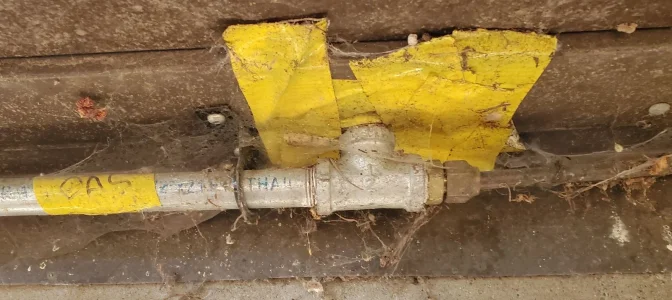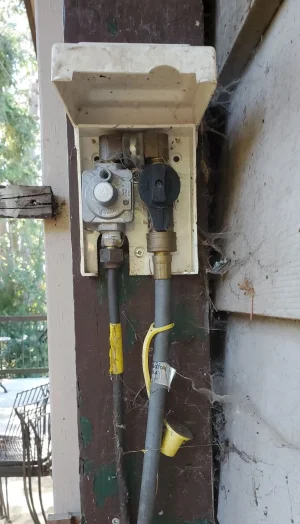slow-poke
Ultra Member
Picked up a new dual fuel BBQ yesterday, also ordered the natural gas conversion kit. Installing the kit seems really simple; remove the propane jets, and replace the propane regulator hose assembly with the supplied natural gas quick connect hose.
Fortunately under the deck and very close to where the BBQ will be located there is a large gas supply pipe that runs along the back of the house on the outside wall just under the deck. Looks to be about 2" and then there is a "T" with a smaller looks like 1" or so pipe that then splits again to feed two indoor fireplaces.
Running the line for the BBQ can be done in a few different ways. At the main T there are two unused capped stubs, one looks to be 1/2 pipe and the other 2".
Option A: install a valve and quick connect to either of those stubs and then use the supplied N.G. quick connect hose to the new quick connect. Downside for the supplied hose to reach, the BBQ will need to shifted over to an ok but less desirable location, or I can order a longer hose. Also the turn off valve will be in a less convenient location.
Option B: Add a 10-15' or so length of the yellow jacketed copper gas pipe to one of the unused ports with the other end being very close to the BBQ terminated with the turn off valve and quick connect right next to the ideal BBQ location.
Two quotes today:
a) $350
b) $750
T junction is easily accessible with just a two foot step. I would imagine a) will take 30 minutes, and b) about an hour.
Obviously this needs to be done by a licensed gas guy for insurance purposes, but the actual job appears near trivial, correct fittings, correct pipe dope, screw them together a few clamps. What is a fair and reasonable price to pay for this?
Location is Ottawa.



Fortunately under the deck and very close to where the BBQ will be located there is a large gas supply pipe that runs along the back of the house on the outside wall just under the deck. Looks to be about 2" and then there is a "T" with a smaller looks like 1" or so pipe that then splits again to feed two indoor fireplaces.
Running the line for the BBQ can be done in a few different ways. At the main T there are two unused capped stubs, one looks to be 1/2 pipe and the other 2".
Option A: install a valve and quick connect to either of those stubs and then use the supplied N.G. quick connect hose to the new quick connect. Downside for the supplied hose to reach, the BBQ will need to shifted over to an ok but less desirable location, or I can order a longer hose. Also the turn off valve will be in a less convenient location.
Option B: Add a 10-15' or so length of the yellow jacketed copper gas pipe to one of the unused ports with the other end being very close to the BBQ terminated with the turn off valve and quick connect right next to the ideal BBQ location.
Two quotes today:
a) $350
b) $750
T junction is easily accessible with just a two foot step. I would imagine a) will take 30 minutes, and b) about an hour.
Obviously this needs to be done by a licensed gas guy for insurance purposes, but the actual job appears near trivial, correct fittings, correct pipe dope, screw them together a few clamps. What is a fair and reasonable price to pay for this?
Location is Ottawa.
Last edited:


